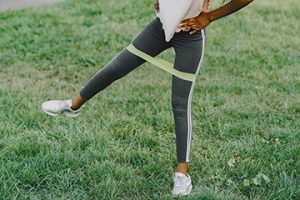 Traditional tools to build strength include barbells and dumbbells. Many people in Houston, TX, focus only on those tools and ignore some less-used options like resistance bands or kettlebells. Resistance bands are inexpensive latex bands. They come in many sizes to match various workout levels. When you stretch them, they provide the resistance that helps build strength. Initially, physical therapists used resistance for rehabilitation. Today they are exercise tools, particularly for those who travel or on the days access to the gym is impossible.
Traditional tools to build strength include barbells and dumbbells. Many people in Houston, TX, focus only on those tools and ignore some less-used options like resistance bands or kettlebells. Resistance bands are inexpensive latex bands. They come in many sizes to match various workout levels. When you stretch them, they provide the resistance that helps build strength. Initially, physical therapists used resistance for rehabilitation. Today they are exercise tools, particularly for those who travel or on the days access to the gym is impossible.
Resistance bands come in various thicknesses and styles.
Some resistance bands look like rubber bands that are bigger and stronger. Others are straight bands with handles on both ends. There are two basic categories of resistance bands, flat ones, and tubes. Flat ones are either sheets or joined at both ends in a circle. Most resistance bands are color-coded based on how light or stretchy they are. Resistance bands range from red, the lightest and stretchiest, to blue, the stiffest and most difficult to use.
Red bands are good for couch potatoes just beginning a strength-building program.
Because the red bands provide light resistance, they’re good for areas that only need a little resistance to build muscle tissue. The next level of resistance is black. These are harder to stretch and a good choice when you want an all-around workout and medium resistance. These are great for bicep workouts. If you already have good muscle tone or want to work on large muscle groups, purple resistance bands are ideal. They provide a medium-to-heavy resistance level.
Green bands are the next level and difficult to stretch.
They’re good for large muscle groups like the legs, back, and chest. The least stretchy and most difficult to use are the blue resistance bands. If you’re doing partnered workouts, these are good options. They’re also good for working leg muscles. Whether you’ve built muscle or not, if you haven’t used resistance bands previously, don’t start with green or blue resistance bands, but use stretchier ones first. As with any type of exercise, proper form is important. Learn the right form on the stretchiest bands and then transfer your knowledge to more difficult bands to build strength.
- Resistance bands are versatile and can work your muscles on many planes and in all directions, unlike weights that use gravity for resistance. For maximum strength-building, use weights, not resistance bands.
- People with limited storage space find resistance bands ideal. You can store them in a drawer or pack them in luggage for travel. They allow you to do strength-building even when you’re miles from the gym.
- You can target specific areas of the body with resistance bands, so they’re perfect for sculpting your body. That also makes them an excellent tool to focus on specific muscles for sports training.
- If you want to add variety to your regular workout, add resistance bands. Lunges, squats, and upper body exercises like curls can use resistance bands. Always check the bands for wear and tear before beginning any exercise.
For more information, contact us today at Rising Fitness Gym
